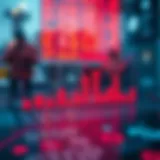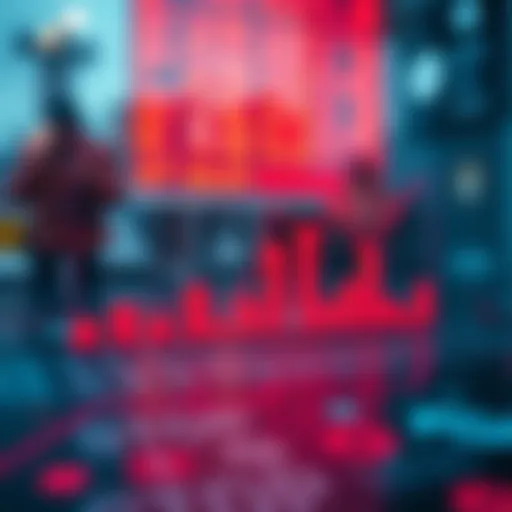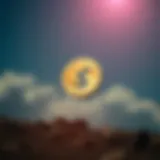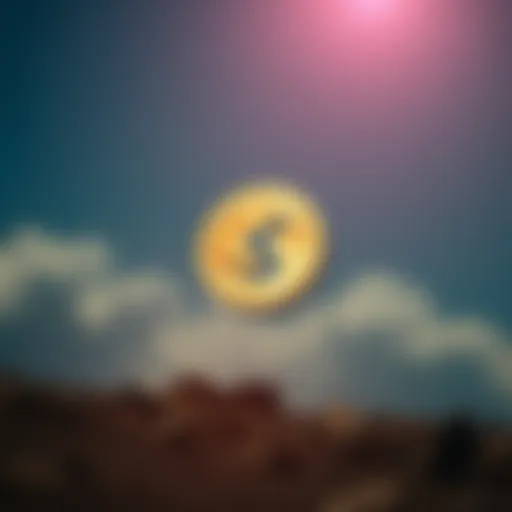Mastering the Art of Digital NFTs Creation

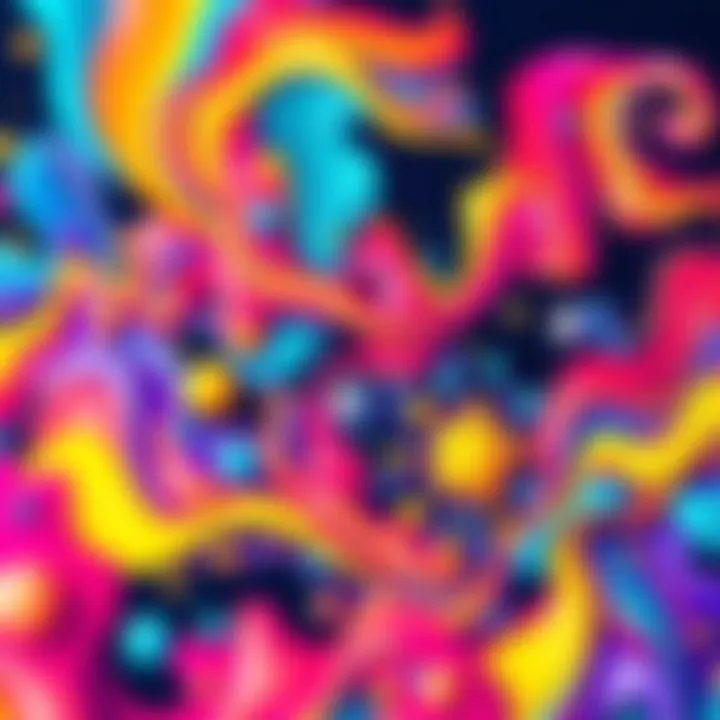
Intro
In the fast-evolving realm of digital art, a fascinating shift is taking place. NFTs, or non-fungible tokens, have revolutionized how artists create, sell, and distribute their work. Unlike traditional art forms, digital art NFTs possess unique attributes tied to blockchain technology, enabling artists to prove ownership and authenticity. This development is opening doors for both emerging creatives and established professionals to explore new avenues for expression and income.
The importance of staying on top of current market trends and emerging technologies can’t be overstated. It influences not just how digital artists create and showcase their work, but also how they navigate the complex world of buying and selling their art.
Let’s kick things off by examining the trends in cryptocurrency, focusing on the currents that are driving the NFT market forward.
Understanding Digital Art
In the ever-evolving landscape of contemporary art, digital art stands out as a significant player. It’s not merely a replication of traditional techniques translated into a digital format; it's a distinct form of creativity that embraces technology at its core. Understanding digital art is crucial in this discourse, especially when we discuss the creation and sales of digital art NFTs. This understanding involves grasping the nuances of how digital art influences the art market and empowers artists in ways that were previously unimaginable.
Digital art spans across various mediums—ranging from digital paintings, animation, 3D modeling, to generative art. This diversity means that artists can express themselves through myriad tools and platforms, allowing for greater creativity. Moreover, as more individuals flock to the digital space, recognizing digital art's relevance becomes essential for both artists and collectors alike.
Benefits of Recognizing Digital Art
- Accessibility: For many, the digital realm serves as a democratized platform where artists can showcase their work to a global audience without the constraints of traditional galleries.
- Innovation: Digital art encourages experimentation. Artists can seamlessly blend different styles, techniques, and genres, pushing the boundaries of creativity.
- Ownership: With the rise of NFTs, creators gain more control over their intellectual property. The blockchain provides a transparent way to verify ownership and authenticity, revolutionizing how art can be bought and sold.
However, it’s not all sunshine and rainbows. The digital art space does present challenges. For instance, as accessibility increases, so does competition. Navigating this landscape requires skill not only in art creation but also in understanding the market dynamics, which will be discussed later in the article.
"In a world where art can be fluid, the digital medium allows for a redefinition of what art can be, opening gateways previously locked tight by tradition."
Advancements in technology have also bolstered the evolution of digital art. From the use of tablets and styluses to sophisticated software like Adobe Photoshop and Blender, artists have an arsenal at their disposal to craft intricate works. As such, comprehending the evolution of digital art will illuminate how it can be harnessed effectively to foster unique NFT collections.
In summary, grasping the significance of digital art is more than an academic exercise; it’s a pivotal step for anyone looking to succeed in creating and selling digital art NFTs. Engaging with this medium not only enriches an artist's portfolio but also expands their footprint in an increasingly digital marketplace.
Prolusion to NFTs
In the realm of digital art, the concept of Non-Fungible Tokens, commonly known as NFTs, has significantly shifted the landscape for artists, collectors, and investors alike. This section delves into what NFTs really are and why they matter, especially as the digital art space grows at an astounding rate. By grasping the importance of NFTs, one can better understand the overarching framework that supports the creation, sale, and ownership of digital art.
At heart, NFTs can be viewed as a revolutionary method of establishing ownership and provenance of digital assets. They are distinct from fungible tokens like cryptocurrencies such as Bitcoin or Ethereum, as each NFT carries unique information that distinguishes it from another. This uniqueness is what essentially allows artists to tokenize their work, giving digital pieces a form of rarity akin to that of traditional art. Moreover, NFTs have opened new revenue streams for artists to monetize their work, offering opportunities to sell directly to fans or collectors without relying heavily on traditional galleries or auction houses.
The significance of NFTs extends beyond mere financial profit. They democratize the art world, providing emerging artists with a platform to showcase their creativity and gain recognition without needing intermediaries. Furthermore, buyers aren't just purchasing images; they are acquiring ownership of the original piece, backed by blockchain's transparency and security. This ownership reinforces value and adds layers of legitimacy to otherwise replicable digital creations.
As we explore the workings of this modern innovation, a comprehension of NFT basics, the underlying technology of blockchain, and the various standards that govern them will foster a solid foundation for creating and engaging with digital art in NFT formats. Let's dissect these concepts to appreciate how they intertwine to form the backbone of NFT art.
What are NFTs?
NFTs are digital assets that represent ownership or proof of authenticity for a unique item in a digital format. Unlike currencies or other tokens, which are interchangeable, NFTs hold specific data that grants each token its uniqueness. Much like how no two paintings by the same artist are identical, NFTs are unique and can’t be exchanged on a one-to-one basis.
Some of the most common forms of NFTs include artworks, collectibles, game items, and even virtual real estate. A distinctive aspect of NFTs is that they are housed on a blockchain, primarily Ethereum, which ensures that ownership records are securely logged and publicly verifiable. This transparency eliminates the risk of fraud and enables artists to track their work's history, including previous ownership and sale price.
In practice, acquiring an NFT might seem similar to buying a physical piece of art. Once you purchase an NFT, the smart contract associated with it is recorded on the blockchain, certifying your ownership. Moreover, many platforms allow artists to embed royalties into their NFTs, ensuring that they receive a percentage of sales each time the NFT changes hands in the future.
Blockchain Technology in NFTs
Blockchain technology is the backbone that supports the functioning of NFTs. At its core, a blockchain is a decentralized ledger that records transactions across many computers in such a way that the registered transactions cannot be altered retroactively, ensuring a high degree of security and trust. In terms of NFTs, this means every transaction related to the particular token—whether it’s the initial sale or subsequent resales—is securely documented.
The role of blockchain enhances the credibility of digital art NFTs significantly. By storing each transaction on a distributed network, blockchain effectively eliminates concerns about authenticity and ownership disputes that plague the traditional art market. This technology provides artists and collectors with an immutable proof of ownership, as well as a transparent history of an item’s title, facilitating easier transfers and sales across borders.
Moreover, using smart contracts on the blockchain allows for automated, enforceable agreements related to the NFTs. These contracts can stipulate specific conditions, such as royalties for artists on future sales, ensuring fair compensation and greater control over their work.
NFT Standards and Types
Not all NFTs are created equal; they come with a range of standards and types. The most common NFT standard is ERC-721, which outlines a set of rules that allow developers to create non-fungible tokens on the Ethereum blockchain. This structure ensures that NFTs can share a common interface and communicate within the ecosystem. There’s also ERC-1155, which offers a more flexible approach, allowing for the creation of both fungible and non-fungible tokens in a single contract, offering efficiency in transactions.
The diversity among NFTs is reflected in the types available today.
- Artworks - Unique pieces created specifically for digital canvases.
- Collectibles - Items that hold value due to rarity, such as digital trading cards.
- Virtual Real Estate - Ownership of digital land or property within virtual environments.
- Gaming Items - Non-fungible assets that can be used within games, like skins or characters.
As the NFT sphere continues to evolve, understanding these various standards and types can empower creators and buyers alike to navigate this new domain confidently. With a firm grasp of what NFTs are, alongside their underlying technology and diversity, one can now appreciate the exciting opportunities that lie ahead in the world of digital art.
The journey to crafting digital art NFTs is multifaceted and intricate, blending creativity with technological know-how. Understanding this process is crucial because it helps artists and investors alike navigate the complexities of the NFT landscape effectively. By grasping how to create and manage these assets, individuals can connect their artistic visions with cutting-edge technology, ensuring both uniqueness and value in a rapidly evolving market. This section delves into the essential elements, benefits, and considerations that accompany the creation of digital art NFTs.
Conceptualization of Art Work
- Research Your Theme: Before you even start sketching or designing, it helps to immerse yourself in the existing art that touches upon your chosen themes. Look beyond conventional sources; think about what resonates with target audiences or the niche you wish to tap into.
- Drafting Ideas: Once you've surrounded yourself with creative inspiration, it's time to brainstorm. Creating rough sketches or mood boards can clarify the direction of your artwork. Remember, there's no one way to layer your concepts, so allow for flexibility.
- Feedback Loop: Engaging peers or potential buyers for feedback can bring new perspectives. This doesn’t mean you should change your vision, but understanding what resonates can sharpen your final outcome.


Tools and Software for Digital Creation
With concepts set in stone, the next task involves selecting the right tools and software for digitally crafting the art. A vast array of options exists, catering to various styles and preferences. Some of the most effective digital creation tools include:
- Adobe Creative Cloud: A powerhouse for artists, the suite offers tools like Photoshop for image manipulation and Illustrator for vector-based designs.
- Procreate: Often favored by illustrators, this iPad app provides a user-friendly interface and a comprehensive brush library.
- Corel Painter: This software emphasizes a natural painting experience, appealing to traditional artists transitioning to digital.
- Blender: A game-changer for 3D artists, its open-source nature allows for extensive manipulation and rendering of digital models.
- Autodesk SketchBook: Ideal for quick sketches and conceptual designs, it highlights intuition over complexity in its interface.
Each software option provides unique features that can help bring your vision to life.
Selecting a Blockchain Platform
Choosing the right blockchain platform is pivotal in the NFT creation process. Not all platforms are equal, and each comes with its own set of benefits and potential drawbacks. Here are key considerations when deciding:
- Transaction Fees: Platforms like Ethereum are highly popular but often have steep gas fees, especially during peak times. In contrast, platforms like Polygon may offer cheaper alternatives.
- User Base and Community: A vibrant user base can enhance the visibility of your NFT. If a marketplace has a robust community, your content has a higher chance of reaching interested collectors.
- Features and Integration: Some platforms provide added features like royalty payments for secondary sales, which can be crucial for artists looking to benefit from future transactions of their work.
- Ecosystem Compatibility: Ensure the platform you choose aligns with the tools and wallet solutions you plan on using. This minimizes complications during the minting process.
Minting Your NFT
Minting your NFT is the cherry on top of the cake when it comes to creating digital art. This process is what transforms a digital file—a painting, a graphic design, or even a bit of music—into a unique, tradable asset in the world of blockchain. This step isn’t just technical; it has implications for ownership, authenticity, and saleability of your art. When an artist mints an NFT, they are essentially certifying the originality and verifiable provenance of their work, which lends it considerable value in a crowded market.
Understanding the Minting Process
To begin with, one must understand that minting involves a few crucial steps. First, you'll need to select the right blockchain. Each blockchain has its own quirks and functionalities. Ethereum, for instance, is the heavyweight champion of NFTs due to its robust smart contract capabilities. However, there are other contenders like Binance Smart Chain, Flow, and Tezos that may offer lower costs or quicker transactions.
Next comes setting up a digital wallet that supports the blockchain you’ve chosen. This wallet will not only store your NFT but will also hold any cryptocurrencies you need for transaction fees—commonly referred to as "gas fees". Understanding these costs is essential; they can fluctuate greatly, affecting your project's budget.
The actual minting happens when you upload your digital artwork to an NFT platform, which in turn creates a unique token on the blockchain. This token includes information about your art, linking it to your digital file. You will include specific details such as the title, description, and any royalties you'll earn from future sales.
"Minting is like signing your name on the dotted line—it’s your stamp of authenticity in the digital art world."
Setting Metadata for Your NFT
The metadata of your NFT is what distinguishes your creation from countless others. This information generally includes a title, description, and royalties, but can also encompass specific traits of your artwork. Artists sometimes use metadata to incorporate URLs or even unlockable content, such as high-resolution files or behind-the-scenes videos, which can enhance the appeal of the NFT.
Here are some essential elements of metadata:
- Title: Your art's name. Make it catchy yet relevant.
- Description: This is your chance to tell a story. Consider what inspired you or what themes your work explores.
- Royalties: Specify how much you’ll earn from future sales. This retains value long after the initial transaction.
- Attributes: If your NFT is part of a series, list out what makes each piece unique.
Choosing the Right NFT Marketplace
Once your NFT is minted, the question arises: where to sell it? Not all marketplaces are created equal, and choosing the right one can impact your sales. Platforms like OpenSea are well-known and have a vast user base, while sites like Rarible offer greater customization options for artists.
Consider these factors when picking your marketplace:
- Fees: Most platforms charge a commission on sales, usually between 2.5% to 15%. This can eat into your profits if you're not careful.
- User Base: Is the marketplace geared toward your style of art? An environment that resonates with your work will attract suitable buyers.
- Features: Look for features that matter to you, such as support for unlockable content or community voting on projects.
The right platform can mean the difference between a handful of sales and a flourishing marketplace for your work. Don't rush this decision; take your time and research.
Using resources like OpenSea, Rarible, or Mintable can provide you insights into various options available.
By understanding the intricacies of the minting process, setting the right metadata, and choosing an appropriate marketplace, you will craft not just an NFT, but a meaningful part of the larger digital art landscape.
Legal and Ethical Considerations
In the realm of digital art NFTs, legal and ethical considerations hold significant weight. The rise of this technology brings with it a barrage of questions related to intellectual property, ownership, and the responsibilities of those involved. As artists venture into the NFT space, understanding these elements not only shields their creative work but also ensures they navigate the market successfully.
Copyright and Ownership Issues
Copyright law is central to owning and protecting artistic creations, and this holds true in the context of digital art NFTs. When an artist creates an NFT, they are essentially minting a digital representation of their work on the blockchain, which can signify ownership. Yet, it does not automatically confer copyright unless explicitly stated.
- What does this mean for artists? It means artists should consider registering their work with a copyright office to establish legal ownership, especially if they plan to sell their art as NFTs. Even if the digital file is minted as an NFT, the underlying copyright usually remains with the creator unless transferred.
- Additionally, it is crucial for artists to draft clear licenses that define how their NFTs can be used. For instance, if a buyer purchases an NFT, can they reproduce it, or use it commercially? A detailed license can clarify these rights and avoid later disputes.
Artists should keep abreast of changes in copyright law, especially as digital and NFT markets evolve.
Addressing Plagiarism in Digital Art
Plagiarism is a persistent concern in the world of digital art, exacerbated by the accessibility of online content. As many artists explore the NFT scene, the risk of unintentionally replicating someone else’s work increases. To combat plagiarism, several proactive steps can be taken:
- Research Thoroughly: Before creating an NFT, artists should ensure their inspiration or elements used in their work aren't too close to existing pieces. Familiarizing themselves with current artists and styles can foster originality.
- Attribution: If an artist draws inspiration from another’s work, it’s wise to give credit where credit is due. This not only shows respect but can help mitigate disputes over originality.
- Watermarking and Digital Signatures: Some artists use these methods to assert ownership of their work, marking it clearly as theirs and protecting it against theft.


Ultimately, maintaining a strong ethical approach ensures the integrity of the NFT community and encourages innovative expression.
Understanding Smart Contracts
Smart contracts are the backbone of transactions in the NFT world, serving as self-executing contracts with the terms directly written into code on the blockchain. Understanding these contracts is pivotal for both artists and collectors:
- Automated Rights Management: Smart contracts can automate key elements such as royalties. For instance, an artist can set terms that ensure they receive a percentage of sales every time their NFT is resold. This creates an ongoing connection between artist and work, enhancing the long-term value of their creations.
- Transparency and Trust: With smart contracts, transactions are transparent and immutable. Artists and buyers can be assured of the authenticity and provenance of the work, thus lessening the chance of fraud.
- Programming Limitations: However, it's also crucial to approach smart contracts cautiously. Errors in coding can create significant issues or potentially lead to loss of funds. Artists should engage with developers familiar with blockchain technology to ensure that their contracts are properly executed.
"In creating art, understanding what is ours is as vital as sharing what we create. Artists must know how to protect their work while exploring new territories that technology offers."
For further reading, refer to these resources: Copyright Basics, Understanding NFTs and Copyright
Marketing and Selling Digital Art NFTs
In the rapidly evolving landscape of digital art NFTs, marketing and selling are pivotal facets that can determine the success of an artist's work and their career trajectory. This topic isn't just an add-on; it's a necessity, much like the easel for a painter. Artists must understand that the visibility of their creations is as critical as the art itself. A strong marketing strategy not only increases reach but also establishes credibility, engenders community engagement, and ultimately translates to sales.
Digital artists must navigate a complex interplay of digital platforms, social media channels, and NFT marketplaces. This interconnectedness means diversifying marketing tactics can yield better results. Here's a closer look at three essential areas for effectively promoting and selling NFTs:
Promoting Your NFT Collection
Promotion is the lifeblood of any sales initiative. For digital art NFTs, this often means a digital presence that is both engaging and authentic. Many artists employ the following strategies:
- Social Media Mastery: Social platforms like Twitter, Instagram, and TikTok are invaluable for showcasing pieces and building a following. Artists should share their process, engage with followers, and post consistently.
- Collaborating with Influencers: Partnering with established figures in the space can introduce your work to a broader audience. When influencers share a piece or create a buzz around a collection, sales can skyrocket.
- Community Engagement: Platforms such as Discord and Reddit offer avenues for artists to join discussions, connect with fans, and attend virtual events or exhibitions. Building these relationships can foster trust and lead to loyal buyers who are eager to support their favorite artists.
"Promotion is not just advertising; it's about telling your story. The more genuine your story, the more likely people are to connect with it."
Understanding Pricing Strategies
Effectively pricing digital art NFTs can make the difference between a sale and a missed opportunity. Several considerations should shape the pricing strategy:
- Cost of Creation: Artists should account for their time, effort, and the resources used during creation. If a piece required extensive effort or specialized tools, it’s fair to reflect that in the price.
- Market Trends: Keeping an eye on what similar pieces are selling for can help in setting a competitive yet reasonable price point. Market research can be done through NFT platforms’ galleries and sales data.
- Rarity and Exclusivity: If a piece is one of a kind or part of a limited series, it should be priced accordingly to reflect its rarity. The scarcity can drive demand and thus justify a higher price.
- Emotional Value: Sometimes artists need to consider the emotional connection their work creates. If a particular piece has a deeper meaning or personal story, don’t shy away from setting a premium price.
Building a Brand as a Digital Artist
In the digital age, an artist's brand is often synonymous with their reputation and influence. Building a brand as a digital artist involves not just showcasing artwork but creating a relatable persona that resonates with potential buyers. Here’s how artists can effectively cultivate their brand:
- Consistent Aesthetic: An artist's portfolio should showcase a consistent style and theme. Whether it's color palette, subject matter, or overall vibe; consistency helps in making an indelible imprint in collectors' minds.
- Authentic Storytelling: Sharing stories behind the artwork can captivate audience interest. Each piece should have context that is shared in artist statements or during interactions on social media.
- Professional Online Presence: Having a polished website or portfolio can immensely boost credibility. Professional photography of the artwork, alongside clear information about purchase options, helps amidst the hustle of the digital marketplace.
- Networking: Building relationships with other artists, collectors, and potential buyers can open doors for opportunities, collaborations, or mentorship. Networking can happen on social media, in online forums, or during digital exhibitions.
By effectively marketing and selling digital art NFTs, artists can create a lasting impact in a competitive market. In a world where every brushstroke is digitized and shared instantaneously, the ability to promote their work can dramatically redefine an artist’s role and success in the digital ecosystem.
Trends in Digital Art NFTs
The world of digital art NFTs is constantly shifting, mirroring the ebb and flow of both technological advancements and consumer interests. Understanding the new trends in digital art NFTs isn't merely an academic exercise; it's crucial for artists, investors, and collectors aspiring to navigate this dynamic marketplace. Trends can signal where the market is heading, what styles or genres are capturing attention, and even how artists can leverage techniques that resonate with audiences. This section digs into the most prominent trends influencing the digital art NFT space, offering insights that can bolster an artist's career or inform investment strategies.
Popular Styles and Themes
As we delve into popular styles and themes of digital art NFTs, it becomes clear that creativity knows no bounds in this realm. Artists are blending traditional art forms with digital innovation in a way that's stirring conversation and consideration. From glitch art—a style emphasizing digital errors—to generative art, where algorithms dictate the aesthetic outcome, the variety is astounding.
Some themes that are currently lighting up NFT platforms include:
- Nature-inspired designs: Many artists are drawing from the beauty of the environment, creating pieces that not only captivate but also resonate with ecological consciousness.
- Abstract art: This style continues to find favor, allowing artists to tap into emotions without the constraints of realistic representation.
- Pop culture references: Artists incorporate elements from movies, music, and social media, offering a familiar touch that invites broader audience engagement.
- Surrealism: With its dream-like visuals, surrealist art thrives in digital formats, often forming unexpected narratives that bend the rules of reality.
These styles reflect a combination of personal intuition and the ongoing dialogue within the art community. The rich tapestry of themes and styles keeps the market engaged, sending ripples of interest across digital platforms.
Impact of Virtual Reality and Augmented Reality
The intersection of digital art with virtual and augmented reality is akin to a brave new world, offering experiences that go well beyond static images. VR and AR are revolutionizing how audiences interact with art, transforming it from a passive experience into an immersive journey. Artists are now able to create environments where viewers can engage directly with their work, either by exploring a virtual gallery or interacting with art pieces through AR applications on their smartphones.
The implications of these technologies are profound. They allow:
- Expanded Horizons: Artists can create entire 3D worlds that can be walked through, offering a spatial awareness that traditional art forms lack.
- Interactivity: Viewers aren't just observers; they can manipulate certain aspects of the art, fostering a sense of ownership and participation.
- New Avenues for Sales: The blend of these technologies with NFTs opens up possibilities for selling experiences, not just images, adding another layer of value to the digital offerings.
Ultimately, VR and AR are not merely tools; they are catalysts for rethinking how digital art can be created, sold, and experienced. As these technologies continue to develop, their influence on the NFT market is likely to deepen.
The Role of Community in NFT Art
Community forms the backbone of the NFT market, acting as both a support system and a driving force behind trends and movements. Unlike traditional art markets, which can often feel insular and elitist, the NFT space thrives on collaboration and shared enthusiasm. Platforms like Discord and Twitter are buzzing hubs where artists gather, share, and critique, fostering a sense of belonging.


Some salient aspects of community influence include:
- Collective Knowledge: Artists can openly share techniques, tools, and resources that help others improve their craft. The collective wisdom of community members is often a goldmine for emerging artists.
- Branding and Promotion: A strong community presence can amplify an artist's voice, with collective sharing leading to wider reach and visibility.
- Support and Validation: In a landscape that can be uncertain and volatile, having a supportive community can provide emotional and practical backing, making the artistic journey less daunting.
In essence, the community is not merely a byproduct of the NFT experience; it is the experience. Engaging with fellow artists and collectors fosters collaboration, pushing boundaries of creativity and growing the market as a whole.
The NFT marketplace is not just a transactional environment; it's a vibrant community that nurtures participation and collaboration.
By observing these trends, artists and investors can better position themselves in a rapidly evolving landscape that demands agility and creativity.
Challenges Faced by Digital Artists
Market Saturation and Competition
The explosion of interest in digital art NFTs has led to an overwhelming influx of artists entering the market. With platforms like OpenSea, Rarible, and Foundation buzzing with new creations daily, standing out becomes a Herculean task. It’s a jungle out there; artists not only have to grapple with their creative process, but they also must find ways to catch the eyes of potential buyers in a sea of offerings.
Key points to consider:
- Quality vs Quantity: In a crowded market, the focus shifts from merely creating art to creating art that resonates with audiences. Originality and storytelling behind each piece can carve a niche.
- Marketing Skills: Artists must develop a knack for promotion. Relying solely on the quality of their work may not suffice. Building a social media presence and engaging with communities can uplift visibility.
- Networking: Collaborating or joining collective exhibitions may help in getting noticed amidst fierce competition.
As seasoned artists may vouch, creative brilliance is just one piece of the puzzle; business acumen is essential too.
Navigating Technical Complexities
Anyone can create digital art, but creating NFTs is a different beast. Artists are often faced with technical challenges that can be formidable, especially for those without a background in blockchain or digital tech. Understanding the nuances of minting, selecting the right blockchain, and integrating wallets can prove daunting.
Considerations for artists:
- Learning Curve: Mastering tools like Metamask or understanding the ins and outs of Ethereum can feel like deciphering hieroglyphics for some. Flat-out tutorials and guides often lack situational context.
- Transaction Fees: Gasp at the gas fees when minting NFTs! Every transaction can cost money. If you’re not careful, you can end up swallowing losses before even selling a piece.
- Security Risks: As much as we love blockchain, it is not immune to hacks and scams. Understanding how to protect one’s digital assets is crucial.
"In the world of digital art, adapting to technological changes is as vital as the art itself."
Understanding Market Volatility
The NFT market is notorious for its volatility. What’s hot today might be forgotten tomorrow. Prices fluctuate like the wind, and trends can come and go overnight. For artists, predicting the right moment to launch or sell can be as tricky as trying to catch smoke with bare hands.
Key aspects to note:
- Riding Trends: While it’s important to stay true to one’s artistic vision, being aware of market trends can help maximize potential earnings. This includes knowing when to drop a collection based on current hype.
- Long vs Short-term Strategy: Artists must decide if they are in it for quick wins or building a legacy. This decision shapes how they navigate the tumultuous waters of the market.
- Emotional Resilience: The fickle nature of the market can take a toll on mental well-being. An artist’s worth should not be dictated by fluctuating prices but rather their passion and creativity.
Navigating these challenges is no small feat. Digital artists need to be prepared, willing to adapt, and stay informed. Without a doubt, the journey is peppered with obstacles, but it’s also filled with opportunities for those who are resilient and resourceful.
The Future of Digital Art NFTs
As we gaze into the horizon of digital art NFTs, it's clear that we are standing on a precipice of transformation. This future is not just about technology; it's about evolving cultural perceptions and market dynamics that could redefine how we experience art. The integration of blockchain in art ownership challenges traditional paradigms, promising artists greater control over their creative outputs and the ability to monetize them in unprecedented ways. This section will delve into three critical aspects shaping the future of digital art NFTs: emerging technologies, the evolution of art ownership, and potential regulatory changes.
Emerging Technologies in Digital Art
The landscape of digital art is increasingly being influenced by emerging technologies such as artificial intelligence, virtual reality, and augmented reality. Each of these innovations has the potential to change how digital art is created, shared, and experienced.
AI-driven tools are already helping artists create unique pieces, pushing the boundaries of creativity beyond what was previously imaginable. Here are a few examples of how these technologies are shaping the realm of digital art NFTs:
- AI-Generated Art: Artists like Refik Anadol utilize AI algorithms to generate stunning visual displays that evolve in real time. These pieces often turn heads in galleries and online marketplaces alike.
- Virtual Reality Experiences: The rise of VR allows collectors to experience artworks in immersive environments, making art consumption more interactive and engaging.
- Augmented Reality Integration: With AR, artists can overlay digital creations onto the physical world, giving viewers a chance to interact with art dynamically, added layers of narrative, and context.
While these advancements enhance the appeal of digital art, they also present challenges in authenticity and originality. The distinction between art created by hand and works generated by algorithms becomes murky, raising questions about value and ownership.
The Evolution of Art Ownership
Ownership of art is undergoing a remarkable evolution with NFTs at the helm. In the past, art was largely confined to physical spaces, but NFTs facilitate ownership in the digital realm, allowing for a broader reach and audience. This transition carries implications worth exploring:
- Fractional Ownership: NFTs can enable fractional shares in high-value digital art. This means collectors can own a piece of a significant work without having to purchase the entire asset, democratizing access to art investment.
- Proof of Authenticity: The blockchain serves as a permanent ledger, providing indisputable proof of authenticity and ownership, thereby reducing cases of forgery and misrepresentation.
- Royalty Payments: Smart contracts enable artists to earn royalties on secondary sales, ensuring they benefit each time their work changes hands, something that traditional art sales rarely accommodate.
As ownership models shift, the role of the artist also transforms. They become not only creators but adaptive entrepreneurs navigating this new terrain.
Potential Regulatory Changes
With the rapid growth of digital art NFTs, regulation is catching up, albeit slowly. Governments and regulatory bodies are beginning to take notice of the implications of digital assets in arts, including:
- Taxation of Digital Assets: As artists and collectors engage in buying and selling NFTs, new tax rules regarding capital gains and income from digital sales are likely to emerge. Understanding these regulations will be crucial for financial planning.
- Consumer Protections: As digital art becomes more mainstream, regulations may address consumer rights related to authenticity and refunds, protecting buyers in a landscape often described as the Wild West.
- Intellectual Property Laws: There will be a need for clearer guidelines on how intellectual property rights apply to NFTs, especially regarding copyright and the potential misuse of digital assets.
"The intersection of art and technology is not just an avenue of innovation, but an entirely new landscape of creative expression and ownership that challenges our long-held ideas about art and its value."
For further reading and insights on digital art and NFTs, you might visit Wikipedia or explore articles on Britannica regarding the evolution of digital art.
